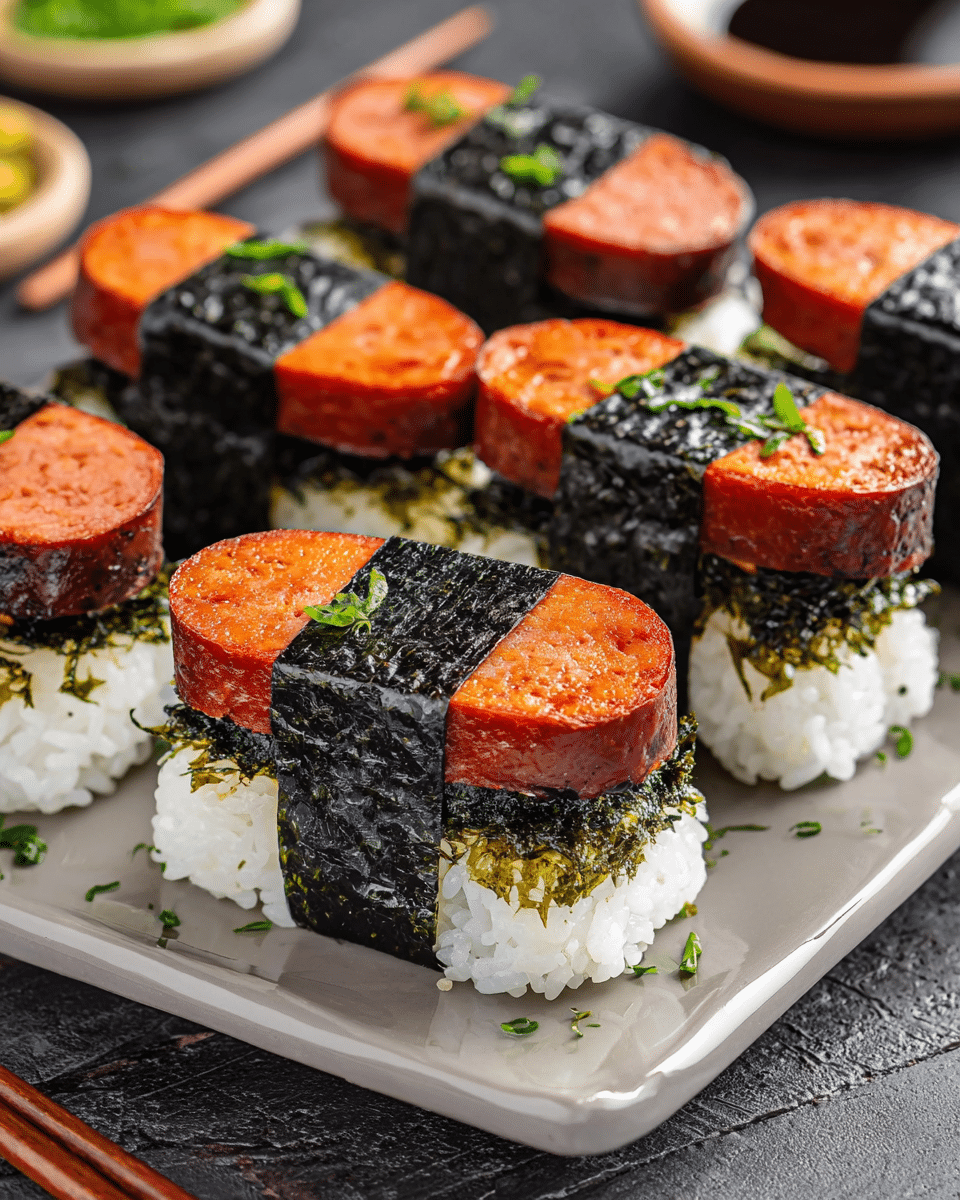Spam Musubi is a beloved Hawaiian snack featuring salty, grilled Spam paired with steamed sticky rice and wrapped in crisp nori seaweed. Quick to assemble and effortlessly portable, it’s perfect for satisfying umami cravings any time of day.
Full Recipe:
Ingredients
-
1 can (approximately 340 g / 12 oz) Spam or similar canned luncheon meat
-
3 tablespoons soy sauce
-
4 tablespoons brown sugar
-
1 tablespoon sesame oil
-
4 roasted sushi nori sheets, each halved to give about 8 strips
-
3 cups (around 555 g cooked) medium‑grain sticky or sushi rice
-
Optional: furikake rice seasoning
Directions
-
Slice the Spam into 8 evenly thick slices.
-
Combine soy sauce, brown sugar, and sesame oil to form a glaze.
-
Heat a skillet over medium heat, add Spam slices, and fry until both sides develop a crunchy golden crust.
-
Immediately after frying, brush or pour the glaze over the Spam and allow it to caramelize briefly—avoid burning.
-
Lay a strip of nori rough‑side up on a flat surface, place a layer of rice, then Spam, more rice, pressing gently into shape using a musubi mold or a cleaned and lined Spam can.
-
Wrap the nori tightly around the rice and meat, sealing the edge by moistening it slightly.
-
Repeat for remaining slices; serve warm or wrap individually for later enjoyment.
Nutrients
-
Calories: ~524 kcal per musubi (≈166 g)
-
Macronutrient breakdown: ~95 g carbohydrates (≈75%), ~7 g fat (≈13%), ~15 g protein (≈12%)
-
Micronutrients: significant iron (~71% DV), potassium (~8% DV), and protein (~27% DV)
Why This Recipe Stands Out
Spam Musubi is a standout snack that blends bold and comforting flavors with easy preparation and portability. The rich saltiness of fried Spam paired with a sweet caramelized glaze creates a delightful flavor contrast that is further enhanced by the tender stickiness of the sushi rice. Wrapped in a crisp sheet of nori, this snack delivers a satisfying combination of textures and umami taste. The beauty of Spam Musubi lies in its fusion of Japanese onigiri and Hawaiian culinary influences, which creates a dish that feels both familiar and excitingly unique. Its simple ingredient list and quick cooking process make it accessible for cooks of all levels, while its portability and satisfying flavor profile make it a favorite among busy people, especially college students and those looking for easy meals on the go.
The dish has become an iconic Hawaiian treat, cherished for its simplicity and versatility. Whether you enjoy it fresh from the pan or packed for later, it offers an unbeatable mix of sweet, salty, and savory flavors wrapped in a convenient handheld form. This balance of taste and texture, combined with minimal effort, makes Spam Musubi a popular choice not only for Hawaiian locals but also for anyone who appreciates quick and delicious comfort food. Its adaptability and ease have helped it become a staple snack, especially favored by students and working professionals who need nourishing food that travels well.
The Benefits of the Ingredients
Spam, while often considered a processed food, provides a valuable source of protein and energy, especially when you need a quick, shelf-stable option. Choosing lower-sodium versions or moderating portion sizes can make it a more balanced choice. The sticky rice component offers complex carbohydrates that help sustain energy levels, making it ideal for long days at school or work. Nori, the seaweed wrap, not only adds a pleasant briny flavor and crunch but is also rich in essential nutrients such as iodine, B vitamins, and trace minerals, all important for overall health.
The glaze made from soy sauce, brown sugar, and sesame oil introduces a harmonious blend of umami and sweetness, enhancing the Spam without overwhelming it. This balance elevates the overall flavor and creates a slightly caramelized exterior that adds a delicious complexity. Adding furikake seasoning, which often includes dried fish flakes, sesame seeds, and seaweed, boosts the nutritional profile further with calcium, magnesium, and antioxidants. Together, these ingredients provide a snack that is flavorful, nourishing, and satisfying while still being easy to prepare.
Cooking Tips
For best results when making Spam Musubi, it’s wise to select a low-sodium version of Spam to keep the salt content in check. Cutting the Spam into even, thin slices ensures that it cooks uniformly and absorbs the glaze evenly, preventing any part from being over- or under-seasoned. Using a musubi mold or a cleaned and lined Spam can makes shaping the musubi much easier and neater. When pressing the rice, aim for a firm but gentle compression so that the musubi holds together without becoming too dense.
Allow the freshly cooked rice to cool just enough so it is warm but manageable to handle—this makes assembly smoother. When cooking the Spam and glazing it, pay close attention to the caramelization stage; once the glaze starts to smell toasted or brown, it’s best to remove it from heat to avoid burning. Keep the nori dry until wrapping to maintain its crisp texture, and use a damp finger to seal the edges effectively. Preparing musubi in advance is simple—just wrap each piece tightly in plastic wrap and store in the fridge, perfect for quick grab-and-go lunches or snacks throughout the week.
Serving Suggestions
Spam Musubi is a fantastic snack or light meal option that suits a wide range of occasions, especially for college students who need easy, portable foods during their hectic days. It pairs excellently with pickled vegetables such as kimchi or a simple cucumber salad, which provide refreshing acidity to balance the richness of the Spam and glaze. Serving it alongside a warm bowl of miso soup or fresh fruit can round out the meal and add nutritional variety.
Because of its convenient size and easy portability, Spam Musubi is ideal for lunch boxes, dorm room meals, or quick study snacks. Wrapping each musubi individually makes them perfect for packing in lunch bags or backpacks, allowing students to enjoy a tasty, satisfying meal anytime, even between classes. The recipe also lends itself well to creative adaptations, such as adding pineapple juice to the glaze for a tropical twist, sprinkling chili flakes for a little heat, or experimenting with different toppings to suit personal tastes. These options make Spam Musubi a flexible recipe that can be tailored to suit any palate or dietary preference.
Conclusion
Spam Musubi is a perfect combination of flavor, convenience, and cultural charm. With just a few simple pantry ingredients, it creates a portable, savory-sweet snack that has become a beloved comfort food across Hawaii and beyond. The satisfying mix of caramelized Spam, sticky rice, and crispy nori delivers bold umami flavors and a delightful texture contrast that makes it both nostalgic and fresh.
For college students especially, Spam Musubi offers a reliable, easy-to-make meal or snack that fits seamlessly into busy schedules. Its grab-and-go nature and ability to be prepared in advance make it a standout option for back-to-school lunches and quick bites between classes. The recipe’s versatility encourages experimentation, whether adjusting the glaze, adding seasoning, or pairing it with fresh or pickled sides, ensuring it remains exciting and adaptable. Ultimately, Spam Musubi captures the spirit of Hawaiian culinary ingenuity in every bite—simple, satisfying, and perfect for nourishing hungry students and busy individuals alike.






